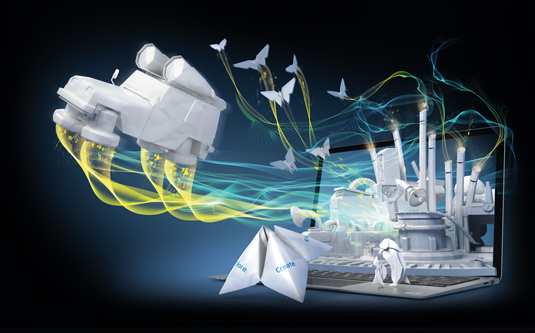Unfolding the possibilities of cloud rendering
How one studio met a "completely impossible" deadline using its own custom cloud-rendering-based solution.
Graphics collective Motion & Image was presented with an interesting challenge: how do you convey the message that Intel-powered laptops are not just thin, but empower users to create, enjoy, and connect?
The solution was to create an origami-inspired world in which opening a laptop unfolds unlimited possibilities. Motion & Image used its own custom cloud-rendering-based solution using modo to render the project; we spoke to director J Walton about how it happened.
You used Amazon's EC2 cloud services for this project. What motivated you to use this solution?
Creating the Amazon EC2 render farm was the brainchild of one of our directors, Brandon Kuchta. The big motivation for EC2 was time; we had an eight-week project that our competitors quoted at more like four to six months. We've used several different render services over the years, and had built up a decent internal render farm. But there's a problem with both of those solutions.
Building an internal farm puts you into the render farm business, and that's not something that really interests us. Sending renders out to a service can work well, but it can be quite expensive and inevitably there's the bottleneck of downloading this massive file directory when the renders finish. On some projects in the past we have spent more time downloading finished renders than was spent actually creating them on the external farm! And we didn’t have time for that with this project.
We had an eight-week project that our competitors quoted at more like four to six months
Enter Amazon EC2 and modo's user-friendly licensing. We created an Amazon EC2 instance with modo installed, and were able to spin up as many as 300 high-speed servers at one time. At the time, modo allowed for up to 50 free render nodes (it's now unlimited) with each licence. One of our compositing artists, Jed Smith, was tasked with developing a Python script that could dynamically spin up EC2 instances, feed individual frames to each one, and then download each frame as it finished.
We spent seven weeks storyboarding, modelling, and animating, and had only one week to light, texture, render and composite the entire four minutes of animation. For most studios that would be completely impossible, for us it was merely very challenging. In all, our Amazon render cloud registered more than 9,000 machine hours during that final week.

What's the difference between a bespoke cloud solution and a dedicated cloud render service?
When comparing our EC2 farm and a rival rendering service, there is a huge disparity in time and especially money. First, we didn't have the time to wait for other projects to clear a queue before ours started, nor did we want to compete for available render nodes. Then there's the cost - an outside farm would probably have cost two or three times as much.
Daily design news, reviews, how-tos and more, as picked by the editors.
Because we don't have to pay extra for render nodes and we can deal directly with Amazon for machine time, we have a real business advantage in quoting for even very complex animation projects. With cloud-based rendering we have all of the infrastructure advantages of a large animation studio, but can maintain the agility and creativity that smaller studios are known for.
This article originally appeared in 3D World issue 175.
Liked this? Read these!
- Discover what's next for Augmented Reality
- Help yourself to these free 3D models
- Check out these inspiring examples of 3D art

The Creative Bloq team is made up of a group of art and design enthusiasts, and has changed and evolved since Creative Bloq began back in 2012. The current website team consists of eight full-time members of staff: Editor Georgia Coggan, Deputy Editor Rosie Hilder, Ecommerce Editor Beren Neale, Senior News Editor Daniel Piper, Editor, Digital Art and 3D Ian Dean, Tech Reviews Editor Erlingur Einarsson, Ecommerce Writer Beth Nicholls and Staff Writer Natalie Fear, as well as a roster of freelancers from around the world. The ImagineFX magazine team also pitch in, ensuring that content from leading digital art publication ImagineFX is represented on Creative Bloq.
